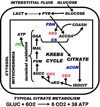A review of the important central role of altered citrate metabolism during the process of stem cell differentiation
- PMID: 24194979
- PMCID: PMC3815687
- DOI: 10.7243/2050-1218-2-1
A review of the important central role of altered citrate metabolism during the process of stem cell differentiation
Abstract
Stem cells are highly proliferating cells that have the potential for differentiation leading to the development of specialized functional cell types. The process of stem cell differentiation requires an increase in the recruitment and population of the undifferentiated stem cells, which are then differentiated to specific functional cell types. Genetic/metabolic transformations in the cellular intermediary energy metabolism are required to provide the bioenergetic, synthetic, and catabolic requirements of the stem cells during this process. However, the identification of the intermediary energy metabolism pathways and their alterations during the proliferation and differentiation of stem cells remain largely unknown; mainly due to the lack of attention and/or required research that focuses on this relationship. In the absence of such information, a full understanding of the factors and conditions required to promote stem cell differentiation leading to development of normal functional metabolic specialized cells cannot be achieved. The purpose of this review is to provide the background and bring attention to the essential relationship of altered cellular intermediary metabolism in the context of the process of stem cell proliferation and differentiation. Citrate metabolism is central to the genetic and metabolic transformation leading to the development of the specialized functional cells. This review identifies the involvement of altered citrate metabolism and the associated genetic alterations of key pathways, enzymes, and transporters; as well as the bioenergetic implications. The importance is emphasized for identification and employment of required conditions to insure that the process of experimental stem cell differentiation results in the development of specialized cells that represent the functional metabolic characteristics and capabilities of their native specialized cells. This is an essential requirement for the successful application of stem cell therapy and regenerative medicine for many pathological conditions.
Keywords: Citrate metabolism; differentiation and proliferation; glycolysis; krebs cycle; osteoblast and bone formation adipogenesis; osteogenesis; stem cells.
Figures









Similar articles
-
The clinical relevance of the metabolism of prostate cancer; zinc and tumor suppression: connecting the dots.Mol Cancer. 2006 May 15;5:17. doi: 10.1186/1476-4598-5-17. Mol Cancer. 2006. PMID: 16700911 Free PMC article. Review.
-
In vitro BMP2 stimulation of osteoblast citrate production in concert with mineralized bone nodule formation.J Regen Med Tissue Eng. 2015;4:2. doi: 10.7243/2050-1218-4-2. Epub 2015 Oct 17. J Regen Med Tissue Eng. 2015. PMID: 26635961 Free PMC article.
-
Energy metabolic capacities of human adipose-derived mesenchymal stromal cells in vitro and their adaptations in osteogenic and adipogenic differentiation.Exp Cell Res. 2018 Sep 15;370(2):632-642. doi: 10.1016/j.yexcr.2018.07.028. Epub 2018 Jul 20. Exp Cell Res. 2018. PMID: 30036541
-
Bioenergetic shifts during transitions between stem cell states (2013 Grover Conference series).Pulm Circ. 2014 Sep;4(3):387-94. doi: 10.1086/677353. Pulm Circ. 2014. PMID: 25621152 Free PMC article. Review.
-
Tumor cell metabolism: the marriage of molecular genetics and proteomics with cellular intermediary metabolism; proceed with caution!Mol Cancer. 2006 Nov 7;5:59. doi: 10.1186/1476-4598-5-59. Mol Cancer. 2006. PMID: 17090311 Free PMC article.
Cited by
-
Citric Acid: A Multifunctional Pharmaceutical Excipient.Pharmaceutics. 2022 Apr 30;14(5):972. doi: 10.3390/pharmaceutics14050972. Pharmaceutics. 2022. PMID: 35631557 Free PMC article. Review.
-
Metabolomic Approaches to Explore Chemical Diversity of Human Breast-Milk, Formula Milk and Bovine Milk.Int J Mol Sci. 2016 Dec 17;17(12):2128. doi: 10.3390/ijms17122128. Int J Mol Sci. 2016. PMID: 27999311 Free PMC article.
-
Evidence that Osteoblasts are Specialized Citrate-producing Cells that Provide the Citrate for Incorporation into the Structure of Bone.Open Bone J. 2014;6:1-7. doi: 10.2174/1876525401406010001. Open Bone J. 2014. PMID: 25745519 Free PMC article.
-
Advances of Glycometabolism Engineering in Chinese Hamster Ovary Cells.Front Bioeng Biotechnol. 2021 Dec 2;9:774175. doi: 10.3389/fbioe.2021.774175. eCollection 2021. Front Bioeng Biotechnol. 2021. PMID: 34926421 Free PMC article. Review.
-
Early passaging of mesenchymal stem cells does not instigate significant modifications in their immunological behavior.Stem Cell Res Ther. 2018 May 2;9(1):121. doi: 10.1186/s13287-018-0867-4. Stem Cell Res Ther. 2018. PMID: 29720263 Free PMC article.
References
-
- Komarova SV, Ataullakhanov FI, Globus RK. Bioenergetics and mitochondrial transmembrane potential during differentiation of cultured osteoblasts. Am J Physiol Cell Physiol. 2000;279:C1220–C1229. - PubMed
-
- Kim JM, Jeong D, Kang HK, Jung SY, Kang SS, Min BM. Osteoclast precursors display dynamic metabolic shifts toward accelerated glucose metabolism at an early stage of RANKL-stimulated osteoclast differentiation. Cell Physiol Biochem. 2007;20:935–946. - PubMed
-
- Teitelbaum SL, Ross FP. Genetic regulation of osteoclast development and function. Nat Rev Genet. 2003;4:638–649. - PubMed
Grants and funding
LinkOut - more resources
Full Text Sources
Other Literature Sources
